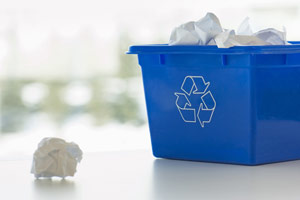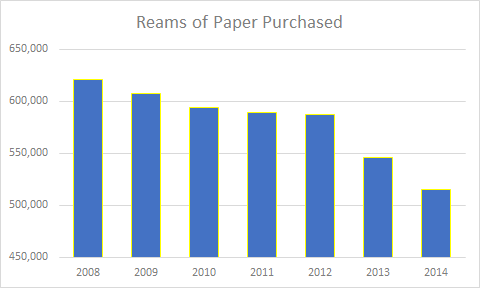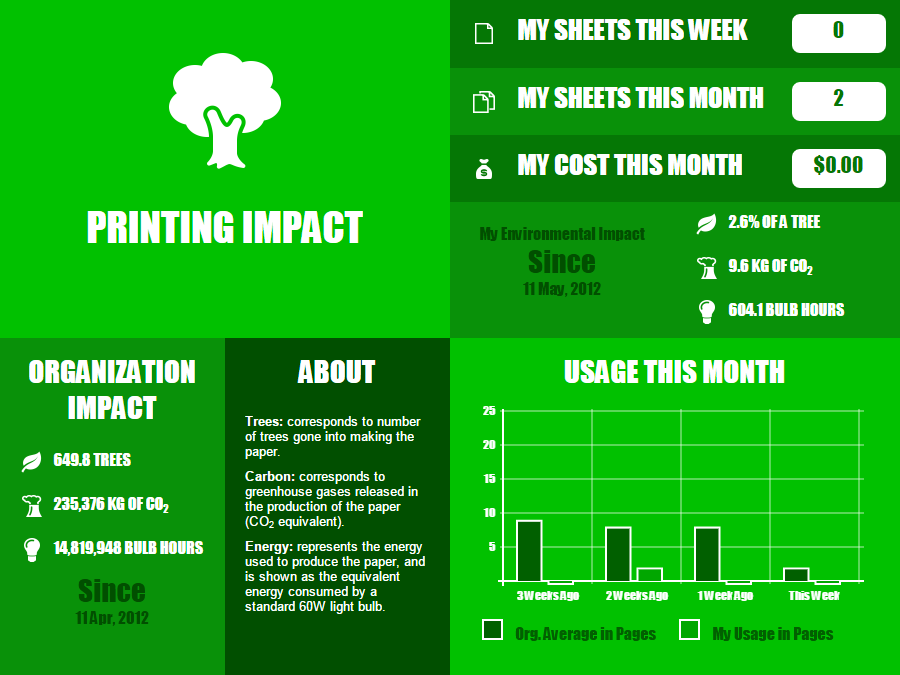Reconsider Printing
How Much Do We Print on Campus?
Approximately 44 million tons (48%) of the paper generated in this country ends up in landfills.1 In 2014, the University of Michigan purchased 514,752 reams of paper, down from 621,360 reams in 2008. We can continue to reduce the paper used and its impact by following the best practices listed below.
What About You?
View how many pages you printed this month and the impact of your printing on the environment by copying and pasting the link below into your web browser and inserting your uniqname at the end:
https://accounts.miprint.it.umich.edu/environment/dashboard/put-your-uniqname-here
Do You Really Need to Print That?
Maybe Not
Ask yourself these questions before deciding to print:
Is this really my final copy?
Check it once more with Print Preview to make sure it looks right.Can I read it another way?
Before printing something to read, consider other ways you could read it. You can print most document formats to .PDF files that can be read on a computer or mobile device.Can I store it electronically?
Instead of filing important documents in paper files, store them electronically. Store your documents using M+Box or M+Google Drive to access the your files anywhere with an Internet connection—much more convenient than carrying around a filing cabinet. Be sure to check the Sensitive Data Guide to make sure your choice of storage is approved for your data.

Sometimes You Do
There are tricks you can use to reduce the impact of printing on the environment:
- Again, use Print Preview to prevent the need to print multiple times.
- Print only final copies of assignments.
- Print double-sided.
- Try narrower margins if they don't conflict with the required report style.
- Ask your professor if she or he will accept and grade assignments electronically.
- Use the printers at Campus Computing Sites to avoid having to power your own printer.
- Always recycle paper when you no longer need it. Better yet, if it's blank on one side, use it as scratch paper and then recycle it. If you enjoy doing a little crafts to relax, search for "diy notepads" for lots of ideas.
- When mass printing, print fewer copies than you think you need. You can always print more if necessary.
Why Print Less?
Over 227 million sheets of paper are purchased by the University of Michigan annually. This is equivalent to cutting down nearly 2 times the amount of trees on campus every year.2
Save Space
- Reduce clutter and space taken up by filing cabinets by storing documents digitally.
Save Time
- Increase work productivity by organizing your files digitally.
- Use cloud storage to access documents from any computer using Google Drive or Box.
Save Money
- The annual cost to maintain a four drawer file cabinet is $1,500.3
- Each misfiled document costs $125. Each lost document cost $350 to $700—large organizations lose a document every 12 seconds.3
- Use digital copies and email to decrease paper and toner expenses.
Save Trees and Other Natural Resources
- The average American uses almost six 40-foot (12-meter) trees of paper a year.4
- Approximately three gallons of water are used to produce a single sheet of paper.3
- Recycling one ton of paper saves around 682.5 gallons of oil.5
Decrease the amount of pages printed by using the tricks listed above.
Faculty
- Do not require students to print off lecture notes or readings. Make materials available online (e.g. in Box or Google) where students can access them from anywhere, including mobile devices.
- Accept electronic submissions and do not print them off. Leverage the capabilities of CTools, Canvas or Box to accept assignments and provide feedback to students.
Conservatree, Trees into Paper
Plant Operations @ University of Michigan, Grounds ServicesThe Paperless Project, Facts About Paper: The Impact of Consumption
The Economist, I'm a Lumberjack
The World Counts, Paper Comes from Trees...
U.S. Environmental Protection Agency


